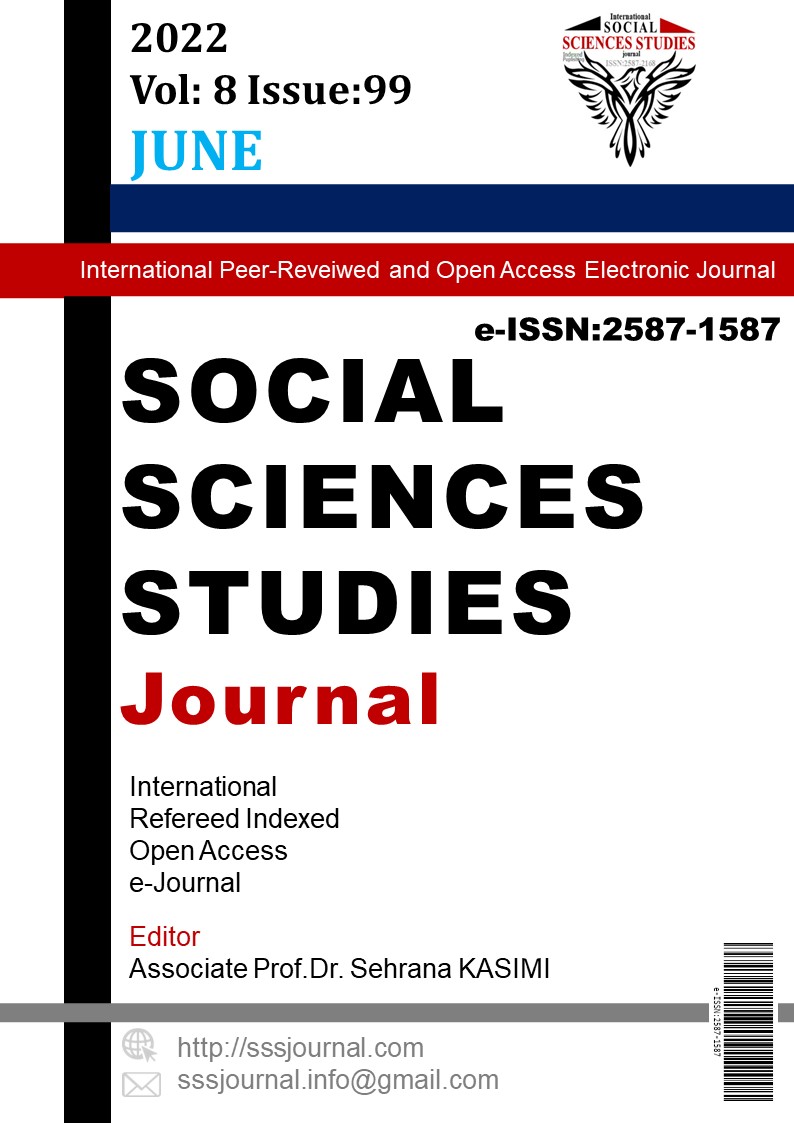Author :
Abstract
1950’li yıllar, Türkiye’nin kentleşme süreci üzerinde derin izler bıraktığı ve etkilerinin günümüze değin devam ettiği bir dönem olmuştur. Demokrat Parti (DP) dönemi olarak da bilinen bu dönem, kırsal kesimden şehirlere doğru göç hareketlerinin başladığı ve en yüksek noktasına ulaştığı, ancak sonradan gerilediği bir dönemin başlangıcını teşkil etmektedir. Bu nedenle DP döneminin Türkiye’nin kentleşme serüveninde özel bir yeri ve ayrı bir önemi vardır. Zirai alanda 1950 ile 1960 yıllarını kapsayan dönemde, makineleşme ve modernizasyon süreciyle birlikte tarımsal üretim ortalama yüzde 80 oranında artış göstermiş, bu da Türkiye’nin ekonomik büyümesini ve ticaretin canlanmasını sağlamıştır. Söz konusu dönemde hayata geçirilen politikalar aracılığıyla, yeni karayollarının yapımıyla yerleşim birimlerinin birbirine bağlanması toplumsal hareketliliği hızlandırmış, kırlardan kentlere doğru yoğun bir göç hareketine neden olmuştur. Türkiye’de kentleşme sürecini büyük oranda belirleyen, kırsal alandaki yapısal dönüşümlerden ziyade, kentsel alanların çekim merkezi haline gelmesi olduğunu söylemek de mümkündür. Bu olgunun ortaya çıkmasında Demokrat Parti iktidarının bilhassa karayolları politikası etkili olmuştur. DP iktidarının yol politikası; köylerin pazara bağlanmasını ve ülkenin en ücra köşesindeki insanlarının kent ve kasabanın pazarına ulaşabilmesini sağlamış; farklı renklerden oluşan, içinde farklılıkları barındıran pazar sayesinde kırsal alandaki insanların da burada yer alabileceği duygusunu harekete geçirmiş, önce hayallerinin sonra umutlarının ve nihayet eylemlerinin dayanağı olmuştur.
Keywords
Abstract
The 1950s was a period in which Turkey’s urbanization process left deep traces with continuing effects until today. This period, which is also known as the Democratic Party (DP) Period, marks the beginning of a period in which migration movements from rural areas to cities began and reached their top point, declining afterward. Therefore, the DP period has a special place and importance in Turkey’s urbanization adventure. Agricultural production increased by an average of 80 percent with the process of mechanization and modernization and led to the economic growth of Turkey and the revival of trade in the agricultural field between 1950 and 1960. The construction of new highways and the connection of settlements to each other through the policies implemented in this period accelerated social mobility causing an intense migration movement from the countryside to the cities. It is possible to argue that urban areas became centers of attraction rather than structural transformations in rural areas that largely determine the urbanization process in Turkey. Especially the “highways policy” of the Democratic Party Government was effective in the emergence of this phenomenon. The “highways policy” of the DP Government ensured that the villages were connected to the market and that the people in the most remote corner of the country could reach the market of the city and the town. This stimulated the feeling that people in rural areas could also take part here thanks to the market, which was made up of different colors, and it became the basis of first their dreams, then their hopes, and finally their actions.
Keywords
- Adıyaman, K. (2008). Kentleşme Sürecinde Türkiye ve Kent Kimliği, (Yayınlanmış Yüksek Lisans Tezi), Selçuk
- Adıyaman, K. (2008). Kentleşme Sürecinde Türkiye ve Kent Kimliği, (Yayınlanmış Yüksek Lisans Tezi), Selçuk Üniversitesi Sosyal Bilimler Enstitüsü, Konya.
- Balcı, M. (2018). “Çok Partili Dönemde Türkiye’de Kentleşme Olgusu”, ECONDER International Academic Journal, 2(1), 8-15.
- Batmaz, N. Y. & Erdem, Ç. (2016). “Türkiye’de 1950-1960 Döneminde Kentleşme Sürecini Siyasi İktidarın Yapısı ve Uygulamaları Açısından Yorumlamak”, Muhafazakâr Düşünce Dergisi, 1(47), 201-213.
- Çakır, H. &Kazkondu, Ş. B. &Aydilek, E. (2020). “Demokrat Parti Döneminde Tüketim Alışkanlıklarında YaşananDönüşüm ve Toplumsal Yansımaları”, Uluslararası Ekonomi Siyaset İnsan ve Toplum Bilimleri Dergisi, 3(3), 134- 146.
- Çakır, S. (2011). “Türkiye’de Göç, Kentleşme/Gecekondu Sorunu ve Üretilen Politikalar”, SDÜ Fen Edebiyat Fakültesi Sosyal Bilimler Dergisi,(23), 209-222.
- Genç, F. N. (2014). “Gecekonduyla Mücadeleden Kentsel Dönüşüme Türkiye’de Kentleşme Politikaları”, Adnan Menderes Üniversitesi, Sosyal Bilimler Enstitüsü Dergisi, 1(1), 15-30.
- Işık, Ş. (2005). “Türkiye’de Kentleşme ve Kentleşme Modelleri”, Ege Coğrafya Dergisi, (14), 57-71.
- Kanca, O. C. (2012). “1950-1960 Arası Türkiye’de Uygulanan Sosyo-Ekonomik Politikalar”, Mustafa Kemal Üniversitesi Sosyal Bilimler Enstitüsü Dergisi, 9(19), 47-63.
- Kayan, A. (2017). “Planlı Dönemden Önce Kentleşme Politikalarındaki Sorunların Günümüze Yansımaları”, International Journal of SocialScienceResearch, 6(2), 158-183.
- Küçükkülahlı, S. (2017). “İktisadi Gelişmenin Gündelik Hayata Etkileri: Demokrat Parti Dönemi İstanbul Örneği”, Uludağ Üniversitesi Fen-Edebiyat Fakültesi Sosyal Bilimler Dergisi, 18(33), 519-554
- Niray, N. (2002). “Tarihsel Süreç İçinde Kentlesme Olgusu Ve Muğla Örneği”, Muğla Üniversitesi Sosyal Bilimler Enstitüsü Dergisi, (9), 1-27.
- Orkut, E. (2017). Demokrat Parti Döneminde Göç, Kentleşme ve Kadın (1950-1960), Yüksek Lisans Tezi, Gazi Üniversitesi Sosyal Bilimler Enstitüsü, Ankara.
- Özer, S. (2014). “Demokrat Parti Dönemi Zirai Makineleşme Hareketi ve Sonuçları”, SDÜ Fen Edebiyat Fakültesi Sosyal Bilimler Dergisi, (31), 61-80
- Öztürk, M. & Altuntepe, N. (2008). “Türkiye’de Kentsel Alanlara Göç Edenlerin Kent Ve Çalışma Hayatına Uyum Durumları:Bir Alan Araştırması”, Journal of Yasar University, 3(11), 1587-1625.
- Öztürk, S. & Çalışkan, H. (2019). “Kentleşme Gelişiminin Ekonomik Büyüme Üzerine Etkisi: Türkiye Örneği”, Iğdır Üniversitesi Sosyal Bilimler Dergisi, (17), 677-694.
- Tosun, G. & Tosun, T. (1995). “Türkiye'de Kentleşme -Siyasal Yapılanma İlişkisi”, Türkiye ve Ortadoğu Amme İdaresi Dergisi, 8(4), 43-63.
- Yıldırım, A. (2004). Kentleşme ve Kentleşme Sürecinde Göçün Suç Olgusu Üzerindeki Etkileri, Yüksek Lisans Tezi, Ankara Üniversitesi Sosyal Bilimler Enstitüsü, Ankara
- Yılmaz, E. & Çiftçi, S. (2011). “Kentlerin Ortaya Çıkışı ve Sosyo-Politik Açıdan Türkiye’de Kentleşme Dönemleri”, Elektronik Sosyal Bilimler Dergisi, 10(35), 252-267.





